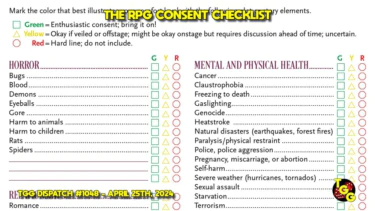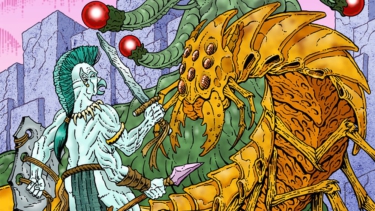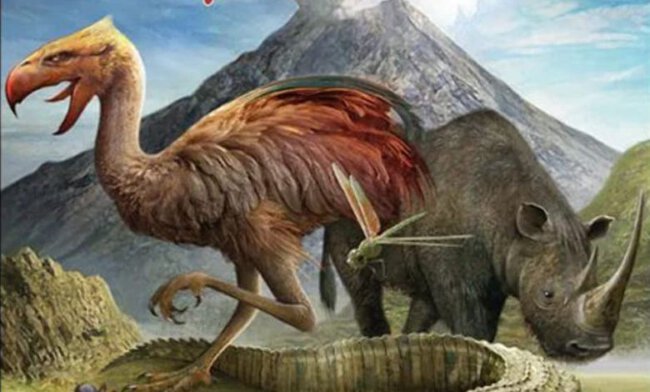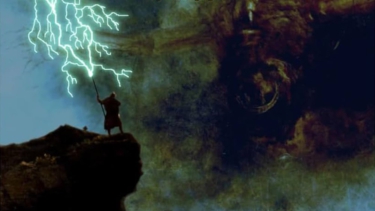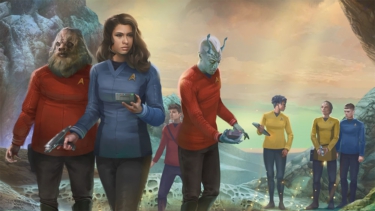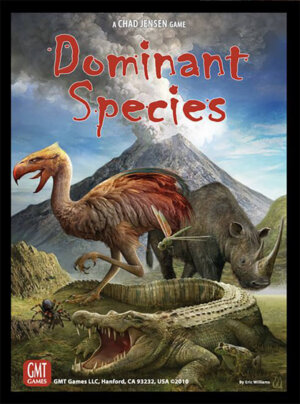
Publisher: GMT Games
Designer: Chad Jensen
Artists: Chad Jensen, Rodger B. MacGowan, Chechu Nieto, and Eric Williams
Genre: Area majority game of survival of the fittest
Year: 2010
Players: Two to six players
Ages: 13+
Playing time: Two to four hours
MSRP: $79.00
GMT is perhaps the premiere publisher devoted to producing top notch wargames. As a company GMT hasn’t dived headfirst into the eurogame market (and I hope they never stop cranking out some of the best traditional style wargames on the market) yet Dominant Species is a departure, as is Twilight Stuggle and Washington’s War, from what gamers might normally expect. Although I wouldn’t call Dominant Species a eurogame it’s certainly not a typical war game. With their latest release, GMT has offered something truly new and unique! What makes me say this about the game? Let’s start with how the game plays out.

Throughout the game large hexagonal tiles are placed to create a board which represents an ever-expanding interpretation our Earth. Or at least our Earth as it might have appeared a hundred thousand years ago! These tiles make up various terrain types such as Desert, Forest, Mountain, Sea, and so on. Smaller Tundra tiles eventually are placed atop these larger tiles converting them into a eighth terrain type in the process. This simulates the approach of the Ice Age and Animals have difficulty surviving, let alone thriving, on the Tundra.
Thriving is the name of the game here because in order to win players need to boost their own Animal’s survivability while, at the same time, pulling the rug out from under their opponents and hopefully collecting victory points in the process. Being king of the hill is important because having “dominance” of a particular terrain type can earn precious Domination cards. These various cards will aid your Animal in its efforts, giving players useful one-time abilities or an opportunity for to score recurring victory points.

All through the game Species (very different from Animals) represented by colored wooden cubes are added to, moved around, and even removed from the Earth. Element markers are also added to, and removed from, both Animals (representing that Animals “need” in order to survive) and the Earth (representing what the planet can “supply”). There are six types of elements that come into play.
Cylindrical Action Pawns (otherwise known as “AP”s) drive the action. Each AP will allow a player to perform the various actions that can be taken in a given turn. Each turn opens with a Planning Phase in which players take turns placing their available APs onto the Action Display indicating a specific action that player wants to perform that turn. Following that is the Execution Phase where the APs are removed in a specific order and their indicated action executed.
Here is a quick rundown of each action in order and a brief description of what takes place:
Initiative – Me first, me first! Simply enough, this determines the order that players will place APs in the following Planning Phases.

Adaptation – Cha, cha, cha, changes! This action and the next deal with elements in play for each Animal. Each Animal starts with two (or three for the Amphibian) identical Elements that can never be lost or replaced. For each AP in Adaptation (3 possible) a player may chose an Element from a pool of four (that were drawn randomly before the turn began) and add it to their Animal’s display. It’s important to have additional elements on your Animal because this plays a big part in what Animal dominates a specific tile.
Regression – Nature giveth and nature taketh away. There will always be at least one element that drops from Adaptation to Regression each turn. Each Animal will lose an Element disk which matches those in Regression unless they play an AP to protect them. It’s important to realize species that have no matching elements on a tile are Endangered and are subject to removal if not somehow saved before the end of the turn.
Abundance – The cupboards are overflowing! This action and the next two deal with the Elements in play. Here an Element, drawn from another pool of four, can be placed on an empty corner on the board – where the elements reside. Those not chosen will drop down to Wasteland in the next turn.
Wasteland – Can anyone spare a grub? One Element can be returned to the supply (using an AP) and then all of the matching Elements on Tundra spaces are removed from the Earth.
Depletion – What was that about the cupboards, smart guy? Elements in Wasteland last turn drop here. One AP will allow the player to remove any one matching Element from the board.
The mechanic of Element dropping is something really new. In effect, an Element not put into play on the first of the turns a particular pool is active, can be removed from play on the following turns. That means it’s better to
take an Element that has only one piece in the pool during Adaptation, or you’ll be stuck trying to defend it on the next. Keep in mind, new pools start every turn.
Glaciation – The Ice Age Cometh! This allows a new Tundra tile to be placed on the board each turn, replacing any type of terrain already there. Any Element that now has Tundra on three corners will be removed. All of the Animals on that tile are reduced to one Species, with the ones removed being returned to their stock. This is the only time that Species removed from the board are returned to a player’s stock. In all other cases, they are removed permanently. And you only have a limited number of species in a given game; once they’re gone, they’re gone.
APs can also be placed in a queue, in order to reserve the action for any of the next three turns. That player, of course, ends up with one less AP to place on those turns.
Speciation – Let’s procreate! This is the method for getting more of your Species on the board. The available actions are keyed to one of the six Element types. You’re looking to populate all of the adjacent spaces to any one of that Element on the board. The
number added is based on the type of terrain tile. Remember, you have a limit to the number of Species to play but there is strength in numbers so you want your species out on the board and not sitting in your stock.
Wanderlust – Look what I found!
Here you will add a new tile to the board. Only the top type of terrain in each of three stacks, and they are visible – not hidden, can be chosen. All adjacent Species have the opportunity to move to this new tile. The space may 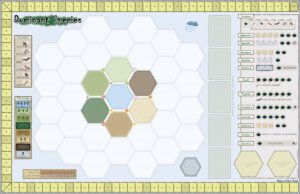
Migration – Movin’ on up! Movin’ on up! This allows players to move Species around the board. I’d say you’d think normally the advantage would be to move last but the earlier your Action on this line allows you to move more Species. Due to the ability of flight, Birds may Migrate two tiles instead of the normal one.
Competition – Finally I get to kill something! Competition allows an AP to be spent so for each Action you may compete in three of the eight terrain types, but one of those is always Tundra. On one tile of each of the terrain types, you are allowed to eliminate one Species. Here you get the choices of going after the player with the most Species in a space, which may affect scoring, or eliminating the last Species of an Animal, which leads to restrictions on what Actions that player can perform. Being the blood thirsty critters they are, Arachnids are allowed a free Competition action each turn.
Domination – It’s good to be king! T

At the end of each turn, those Endangered Species die off and are removed from play. There is also a scoring made for the player that has the most Species on Tundra tiles. Then, if the game isn’t over, the Action Display is prepared for the next turn by placing the new pools of Elements, Dominance Cards, and Terrain tiles. This is known as the Reset.
The sequence of play is repeated until the Ice Age hits. When the Ice Age card triggers the end of the game, players conduct a final scoring of each tile—after which the player controlling the Animal with the highest VP total wins the game.
So what are my thoughts on Dominant Species? I think this is a great game for players who are willing to invest an evening in playing a single game. You certainly will end up spending the full two-four hours stated on the box but, in my opinion, that’s a good thing. I enjoy a deep game and this latest release from GMT is truly that. Remember I just wrote deep, not complex; a few turns into your first game you’ll understand the flow of the play sequence and that’s when you’ll begin to devise your strategies, thus refining them for future plays. Teaching this game is not a daunting task either. Having the Action Summaries printed on the Animal Displays also means that you don’t have to dive into the rulebook very often to clarify what’s taking place or how to resolve an action.
I certainly wouldn’t recommend Dominant Species for the casual gamer by any stretch and certainly not for someone who begins to yawn and roll their eyes once the sixty minute mark of any game is reached. And don’t even glance at the title if any of your gaming gang gets a good dose of a different kind of AP (Analysis Paralysis) from time to time! But for those of us who enjoy a good dose of strategy, with just a smidgen of luck involved, this is a must buy!
The components are top notch (as usual from GMT) and you really do get your money’s worth even if you pay the full retail price of $79 U.S. Be careful when you try to pick up the box – this is one hefty game!
Kudos to GMT and Chad Jensen for providing what is, in my opinion, only the second game to be rated a 9+ here at TGG!






